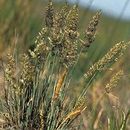Brief Summary
(
англиски
)
добавил Ecomare
Grey hair-grass grows in small dense tussocks and easily resembles a head of hair. However, not a soft head of hair. Its long narrow leaves are covered in tiny prickles. Thanks to its tolerance of high temperatures and lack of water, it is a perfect plant for the open dry Dutch dunes. It is often one of the first plants to grow in a sand-drift. As soon as too many other plants take root in the same area, this grass will start to disappear. Grey hair-grass is ingenious in containing water, using its fine side roots as a kind of net around the parent root, like a sock.
- лиценца
- cc-by-nc
- авторски права
- Copyright Ecomare
Comprehensive Description
(
англиски
)
добавил North American Flora
Corynephorus canescens (L.) Beauv. Agrost. 90, 149, 159. 1812
Aira canescens L. Sp. PI. 65. 1753.
Avena canescens Weber, in Wiggers, Prim. Fl. Holsat. 9. 1780. (Based on Aira canescens L.)
Weingaerlneria canescens Bemh. Syst. Verz. Pfl. 23, 51. 1800. (Based on Aira canescens L.)
Culms much branched at the base, tufted, erect, glabrous, 15-30 cm. tall; sheaths roughish, usually purple; ligule obtuse, 2-3 mm. long; blades filiform, involute, scabrous, mostly basal, rather stiff; panicle erect, spikelike or somewhat open, 3-8 cm. long, the axis roughish, the branches appressed; spikelets 2-flowered; glumes nearly equal, about 3 mm. long, pinkish, acute, minutely scabrous; lemmas somewhat pilose at base; awn about as long as the glumes, brown and tightly twisted below, white above, the summit somewhat thickened.
Tyte locality: Europe.
Distribution; Sandy open ground and waste places, introduced at a few places in the eastern United States; native of Europe.
- библиографски навод
- Albert Spear Hitchcock, Jason Richard Swallen, Agnes Chase. 1939. (POALES); POACEAE (pars). North American flora. vol 17(8). New York Botanical Garden, New York, NY
Physical Description
(
англиски
)
добавил USDA PLANTS text
Perennials, Terrestrial, not aquatic, Stems nodes swollen or brittle, Stems erect or ascending, St ems geniculate, decumbent, or lax, sometimes rooting at nodes, Stems caespitose, tufted, or clustered, Stems terete, round in cross section, or polygonal, Stem internodes hollow, Stems with inflorescence less than 1 m tall, Stems, culms, or scapes exceeding basal leaves, Leaves mostly basal, below middle of stem, Leaves conspicuously 2-ranked, distichous, Leaves sheathing at base, Leaf sheath mostly open, or loose, Leaf sheath smooth, glabrous, Leaf sheath and blade differentiated, Leaf blades linear, Leaf blades very narrow or filiform, less than 2 mm wide, Leaf blade margins folded, involute, or conduplicate, Leaf blades mostly glabrous, Leaf blades scabrous, roughened, or wrinkled, Leaf blades glaucous, blue-green, or grey, or with white glands, Ligule present, Ligule an unfringed eciliate membrane, Inflorescence terminal, Inflorescence a contracted panicle, narrowly paniculate, branches appressed or ascending, Inflorescence a dense slender spike-like panicle or raceme, branches contracted, Inflorescence solitary, with 1 spike, fascicle, glomerule, head, or cluster per stem or culm, Inflorescence with 2-10 branches, Flowers bisexual, Spikelets pedicellate, Spikelets laterally compressed, Spikelet less than 3 mm wide, Spikelets with 2 florets, Spikelets solitary at rachis nodes, Spikelets all alike and fertille, Spikelets bisexual, Spikelets disarticulating above the glumes, glumes persistent, Spikelets disarticulating beneath or between the florets, Rachilla or pedicel glabrous, Glumes present, empty bracts, Glumes 2 clearly present, Glumes equal or subequal, Glumes equal to or longer than adjacent lemma, Glume equal to or longer than spikelet, Glumes keeled or winged, Glumes 1 nerved, Lemmas thin, chartaceous, hyaline, cartilaginous, or membranous, Lemma 5-7 nerved, Lemma glabrous, Lemma apex dentate, 2-fid, Lemma distinctly awned, more than 2-3 mm, Lemma with 1 awn, Lemma awn less than 1 cm long, Lemma awn subapical or dorsal, Lemma awn twisted, spirally coiled at base, like a corkscrew, Lemma awn once geniculate, bent once, Lemma margins thin, lying flat, Lemma straight, Palea present, well developed, Palea membranous, hyaline, Palea shorter than lemma, Stamens 3, Styles 2-fid, deeply 2-branched, Stigmas 2, Fruit - caryopsis, Caryopsis ellipsoid, longitudinally grooved, hilum long-linear.

